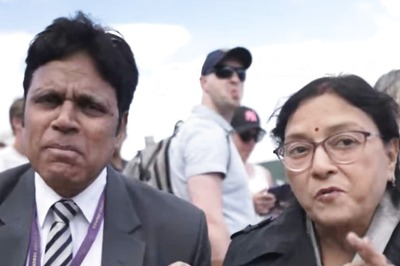
views
A few decades ago, obesity was not considered a public health issue. Even as late as the 1990s, obesity was only seen as a western concern, whereas undernutrition was more of a problem for developing nations like India. However, obesity is now afflicting more than 44 per cent of the world’s population. According to the data from the fifth round of the National Family Health Survey (NFHS), India is not far behind. Most government regimes have focused their efforts in recent years on combating malnutrition, with many schemes launched across the country. While the focus was important for that time, new data on obesity suggests that we may have forgotten the obesity burden.
NFHS 5: How Obese are We?
The NFHS 5 data shows that obesity is on the rise in majority of states and union territories. The problem appeared more concerning in children. Obesity among children under the age of five has increased, with 33 states and union territories reporting an increase in the number of overweight youngsters. The proportion of overweight children grew from 2.1 per cent in NFHS-4 to 3.4 per cent in NFHS-5.
In terms of gender, obesity has increased by 4 per cent in both men and women in India during the last five years. In NFHS-5, the percentage of overweight or obese women is 24, up from 20.6 per cent in NFHS-4 (2015-16). The prevalence in men increased to 22.9 per cent (NFHS-5) from 18.9 per cent (NFHS-4).
Obesity is also more prevalent in urban areas. Places such as Puducherry, Delhi and Chandigarh are some of the worst performers with almost half their population overweight. A trend is also seen where the wealthiest are four times more likely to be overweight than the poorest. This can partially be attributed to the difference in occupation and access to food. Urban men are almost twice as likely to be overweight than their rural counterparts. Such a huge difference between urban and rural is not seen among women.
This was the first survey which calculated Waist-to-Hip Ratio (WHR) to identify percentage of body fat and serves as a proxy for abdominal fat. This ratio when combined with the Body Mass Index (BMI) can more accurately predict a rise in risk of diabetes, stroke and heart attacks. More men have a bigger WHR (48 per cent) compared to women (40 per cent). Jammu and Kashmir (88 per cent) reported the highest proportion of women having a substantially increased risk of WHR while Madhya Pradesh reported the lowest (40 per cent). For men it is highest in Chandigarh (67 per cent) and lowest in Meghalaya (25 per cent).
ALSO READ | Why Women Face More Food Insecurity Than Men
Not Just a Rich World Problem
According to a recent World Bank research, obesity rates have gone up since 1975. Obesity and being overweight have always been an issue in affluent and developed countries. In the early 2000s, the United States, the United Kingdom and Australia began to recognise this, and it was projected that there is a direct association between obesity and increased caloric intake, predominantly seen in richer parts of the world. However, less developed regions such as Latin America, Africa and South Asia too have seen a dramatic growth in the percentage of obese people over the years. In fact, a little more than 70 per cent of all obese persons now live in low- and middle-income countries. For these countries there is a dichotomy playing out as they are grappling with both cases of undernutrition and obesity. This increases the work of developing and executing policies.
India’s Focus on Malnutrition
We as a country have always focused on malnutrition and that was the right approach a decade ago. But now with increase in obesity, the country also needs to focus more on obesity related malnutrition. India is now at a stage of development where it has to tackle the doubly whammy of nutrition imbalance. There is a significant proportion of the population suffering from lack of food; and many people are now eating food beyond requirement. All large government interventions such as Integrated Child Development Scheme, Mid Day Meal and public distribution schemes have focused on undernutrition. It is now time we add obesity prevention and treatment to our arsenal to fight overall nutrition-related disorders.
Health Effects of Obesity
Obesity brings with itself a lot of metabolic diseases. Being overweight puts the individual at a greater risk of heart attack, diabetes, stroke, high blood pressure. It can also lead to degeneration of joints. Obese people are at a higher risk of suffering from certain kinds of cancers (including endometrial, breast, ovarian, prostate, liver, gallbladder, kidney, and colon). Moreover, being overweight also places you at an increased risk of death due to COVID-19.
Trends over the Years
Obesity and overweight were identified as a developing problem in India in the third round of the NFHS (2005-2006), with the percentage of married women (age 15-49) who were overweight or obese increasing from 11 per cent in NFHS-2 to 15 per cent in NFHS-3. The third survey also found out that Indian women suffer from a dual burden of malnutrition, with nearly half (48 per cent) being either too thin or overweight. The NFHS-4 concluded that this number had risen from 15 per cent to 23 per cent in 2015-16. In the case of men, there was an increase from 9.3 per cent in NFHS-3 to 19 per cent in NFHS-4.
The data across various rounds of National Family Health Surveys shows that obesity has become one of the major metabolic risk factors for increase in non-communicable diseases (NCDs), which account for more than 60 per cent of all deaths in India.
What is Making India Obese?
It is imperative to understand that the cause of obesity is the mismatch between calorie consumption and expenditure. With the decrease in physical activity coupled with increase in energy dense food, obesity has been on a rise. People are now adopting a more sedentary lifestyle leading to a decrease in energy expenditure. Increase in urbanisation and changes in transportation and employment further aggravate this problem.
This is not just the case in India. All over the world there is paucity of information among general public to help them adjust to the changes in their habits and environment and ameliorate the damage caused by the obesity problem.
How Can India Tackle the Double Burden?
As we are slowly getting out of the clutches of hunger, we have to also take care that we don’t fall into the obesity trap. India has been doing a lot when it comes to malnutrition and we have been slowly getting the results. It is of utmost importance that India’s population consumes a healthy diet. A diet which is balanced and has the right food in the right quantity. The government has been taking some steps in this direction, such as the Health Star Rating on packaged food items.
More steps like these that make people aware of the harmful ingredients in their food will be welcome. There is a need for government regulation of added salt, sugar and fats to packaged products. There is also a need to encourage early screening of lifestyle diseases and educating people about prevention. Children have to be encouraged to do more physical activity and should be nudged towards a healthier diet. Educating adults about the benefits of a more active lifestyle is a necessary step. It is also important to make sure that people have access to cheap and nutritious food. The government also has to focus on integration of lifestyle and diet changes into our current medical system.
The countless steps aimed at nutritional needs have been successful in reversing the trends in undernutrition prevalence but have neglected the rising trends in obesity. Obesity is linked with a range of adverse physical and mental health outcomes, as well as some negative societal outcomes. Hence it is important that immediate steps are taken to reduce the risk factors for obesity to ensure the health and welfare of the entire population.
Dr Harshit Kukreja is Research Analyst with The Takshashila Institution. Mahek Nankani is Assistant Programme Manager at The Takshashila Institution. The views expressed in this article are those of the authors and do not represent the stand of this publication.
Read all the Latest Opinions here




















Comments
0 comment